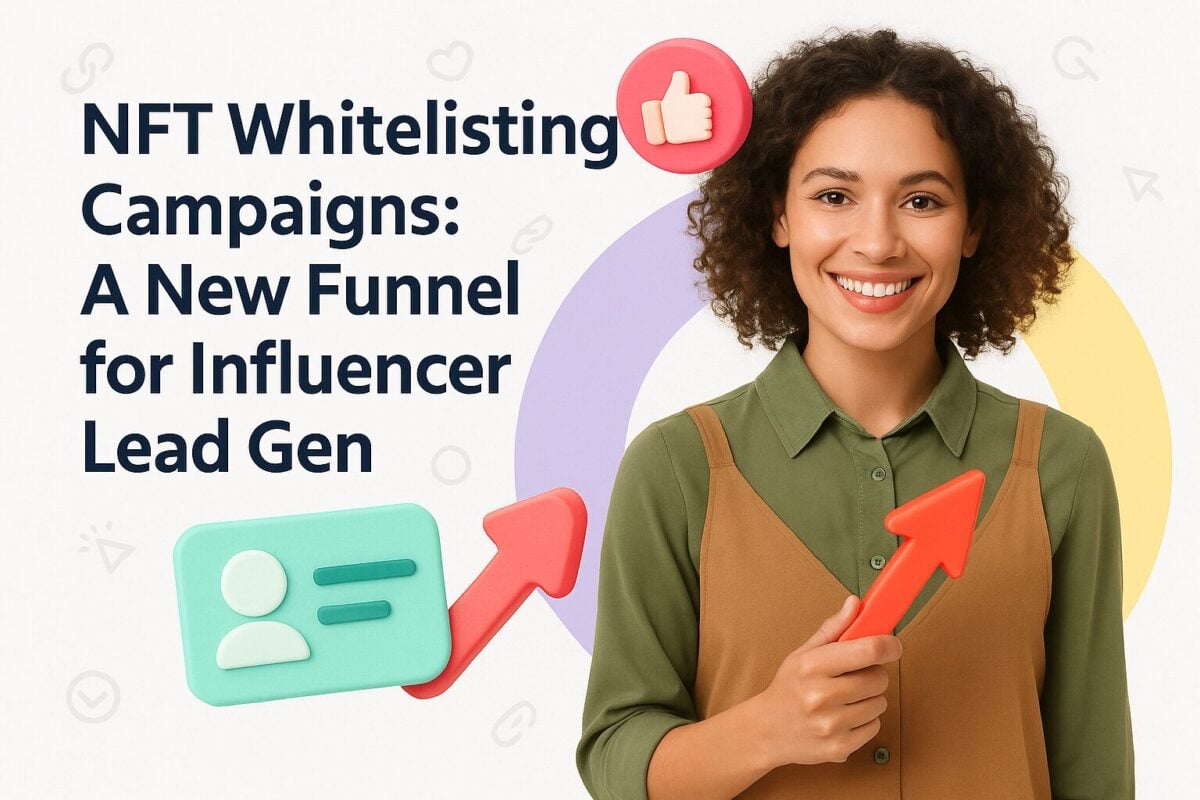Unlock Influencer Lead Generation: A New Funnel for Maximum Engagement

Transforming NFT Whitelists into Strategic Lead Generation Tools
NFT whitelisting has transitioned from a mere presale incentive to a sophisticated mechanism for generating leads, driven by collaborations with influencers and community engagement initiatives. Brands are now tasked with utilizing limited allowlist slots to attract high-intent prospects and ensure consistent mint conversions. Additionally, emerging trends are redefining how one-time giveaways evolve into scalable campaigns that deliver transparent returns on investment (ROI).
- Understanding Whitelisting Campaign Mechanics
- Whitelist vs. Allowlist: Clarifying Terminology
- Common Models for Whitelist Entry
- Allocating Whitelist Slots: Scarcity and Wallet Limits
- Leveraging Influencers for Lead Generation
- Reserved Slots for Content Creators
- Engaging Notable NFT Holders
- Building a High-Intent Lead Capture Funnel
- Unified Data Ingestion
- Qualification and Scoring Matrix
- CRM Integration and Automated Workflows
- Real-Time KPI Tracking
- Community Engagement and Filtering Tactics
- Engagement-First Entry Mechanisms
- Ambassador Programs
- Behavioral Analytics for Quality Control
- Feedback Loops and Iterative Refinement
- Conclusion: Elevating Whitelists into Lead-Generation Powerhouses
Understanding Whitelisting Campaign Mechanics
Before diving into specific models, it’s essential to view whitelist mechanics as vital elements of a structured influencer campaign lifecycle. By aligning entry methods with the stages of your influencer roadmap—Discovery, Activation, and Amplification—you can ensure that whitelist initiatives function cohesively within your broader marketing strategy. This alignment fosters accountability regarding lead sourcing, wallet verification, and conversion reporting.
Whitelist vs. Allowlist: Clarifying Terminology
To avoid confusion, agencies and marketers should standardize their terminology across all platforms. Choose either “allowlist” or “whitelist” and use it consistently in social media posts, Discord channels, and email communications. Clearly define what the list offers—early access, discounted prices, guaranteed mints, or a combination of these—and include this information in FAQs, landing pages, and automated responses. Consistent terminology signals professionalism and sets clear expectations for potential leads.
Common Models for Whitelist Entry
NFT projects typically employ three primary entry models:
-
Public Form Sign-Up: Many brands utilize platforms like Typeform or Google Forms to gather wallet addresses, email contacts, social media handles, and optional qualifying questions. This straightforward model allows for easy tracking of conversion rates from form submissions to successful mints.
-
Discord-Driven Entry: By leveraging Discord’s reaction roles and custom bots, projects can assign entry roles to members who complete specific tasks, such as posting memes or answering trivia. This approach not only builds community but also captures leads effectively.
-
Social Media Contests & Challenges: Engaging activities like meme contests or art challenges encourage broader social interaction. Winners receive whitelist spots, which helps identify creative advocates and generates user-generated content (UGC) for influencer marketing.
Each model should integrate with your customer relationship management (CRM) system or campaign dashboard to ensure that every lead’s origin is traceable, allowing for effective segmentation and retargeting.
Allocating Whitelist Slots: Scarcity and Wallet Limits
Creating a sense of scarcity is crucial for attracting high-intent leads. By limiting whitelist spots to a small percentage of the total supply—typically 10-20%—you instill urgency and encourage quick participation. Implementing a “one spot per wallet” rule ensures unique registrations and mitigates the risk of bot interference.
- Scarcity Messaging: Use countdown timers on landing pages to display remaining spots, updated in real time through API connections to your whitelist database.
- Wallet Verification: Automate checks during sign-up to confirm that addresses have not registered multiple times, utilizing on-chain lookups or off-chain logic.
- Tiered Allocation: For larger campaigns, consider creating tiers—such as “Platinum” spots for top partners and “Community” spots for public contests—each offering different benefits.
By thoughtfully designing these mechanisms, you not only protect against dilution and bot abuse but also create an early-stage funnel that aligns with sales KPIs.
Leveraging Influencers for Lead Generation
Integrating influencer allocations into your campaign framework requires a structured, repeatable model that aligns creative deliverables with performance analytics. Clearly defining roles within your team—covering influencer sourcing, contract negotiation, and post-mint reporting—can streamline the process.
Reserved Slots for Content Creators
Brands should set clear guidelines for influencer whitelist allocations:
- Deliverables and Spots: Specify a minimum content package in exchange for a certain number of whitelist spots, ensuring both parties understand their commitments.
- Performance Tiers: Allocate slots based on influencer reach, rewarding micro-creators and macro-influencers differently to balance budget and engagement.
- Trackable Links: Use custom referral links to attribute each whitelist sign-up to specific influencers, allowing for effective ROI comparisons.
Engaging Notable NFT Holders
Recognized NFT holders can serve as valuable leads for whitelist invitations. Projects can identify these individuals through on-chain data queries and extend exclusive invites.
- On-Chain Qualification: Use blockchain explorers or APIs to filter addresses holding specific NFTs, creating a list of notable holders based on criteria like collection reputation.
- Automated Outreach: Utilize bots to send personalized invites to these holders, emphasizing the mutual benefits of their participation.
- User-Generated Content: Amplify content from notable holders post-mint to generate social proof and encourage further sign-ups.
Building a High-Intent Lead Capture Funnel
To convert fragmented whitelist entries into a cohesive sales funnel, each data touchpoint must be structured as a lead stage—capturing, qualifying, activating, and converting prospects through integrated systems.
Unified Data Ingestion
Consolidate all whitelist sign-up channels into a centralized Customer Data Platform (CDP). Configure webhooks to push real-time data containing wallet addresses and entry metadata, ensuring every lead enters your system with a complete engagement profile.
Qualification and Scoring Matrix
Assign weighted scores to leads based on both on-chain and off-chain signals, such as:
- Acquisition Source: Differentiate scores based on entry methods, rewarding higher engagement sources.
- On-Chain Credentials: Recognize holders of flagship NFTs and previous mint history with higher scores.
- Behavioral Signals: Track actions like email click-throughs and wallet verification completion to gauge intent.
Define a threshold score to transition leads into a “Hot Presale” segment, while others enter an “Engaged Nurture” workflow.
CRM Integration and Automated Workflows
Utilize your marketing automation platform to orchestrate multi-channel nurture streams:
- Trigger-Based Emails: Send immediate confirmation emails upon registration, including wallet verification instructions.
- Progressive Profiling: After verification, prompt leads for preferences to enrich their profiles.
- Retargeting Audiences: Use hashed emails and wallet addresses for targeted ad delivery.
Real-Time KPI Tracking
Deploy a unified dashboard to monitor key performance indicators, including:
- Funnel Conversion Rates: Track the journey from registration to mint and secondary-market activity.
- Channel Attribution: Analyze the effectiveness of different entry channels.
- Cost Per Acquisition: Compare presale costs against historical data to optimize budget allocation.
Community Engagement and Filtering Tactics
To maintain whitelist integrity and foster genuine brand advocacy, community engagement should combine gamified mechanics with stringent quality filters.
Engagement-First Entry Mechanisms
Create tiered community quests that organically promote advocacy:
- Meme Contests: Encourage members to create project-themed memes, rewarding top performers with whitelist spots.
- Live Events: Host interactive sessions requiring participants to demonstrate product knowledge for whitelist eligibility.
Ambassador Programs
Recognize top contributors as “Whitelist Ambassadors,” empowering them to distribute exclusive spots within their networks. This peer-to-peer vetting enhances reach while maintaining lead quality.
Behavioral Analytics for Quality Control
Implement community analytics tools to monitor engagement patterns and identify non-human behavior, ensuring only genuine participants gain access.
Feedback Loops and Iterative Refinement
Post-campaign, survey participants to gather insights on task clarity and perceived value. Use this feedback to refine future engagement strategies.
Conclusion: Elevating Whitelists into Lead-Generation Powerhouses
By embedding whitelist mechanics into influencer briefs, brands can transform early-access lists into effective lead magnets. Centralizing data ingestion and applying a robust scoring matrix ensures that every wallet address represents a qualified prospect. Coupling community engagement tactics with influencer-driven amplification creates a scalable funnel that delivers measurable ROI and predictable presale revenue.
Adopting these frameworks and refining them through feedback loops will not only secure high-intent leads for each NFT drop but also establish a repeatable model that enhances your marketing capabilities in the Web3 landscape. Start implementing these strategies today to drive community momentum and achieve significant business impact.







